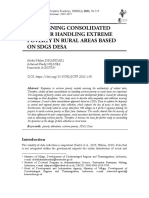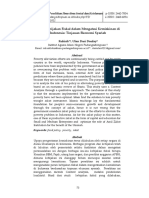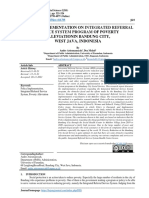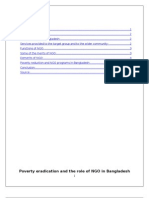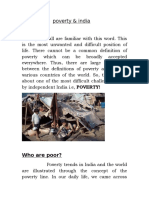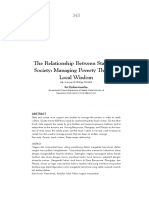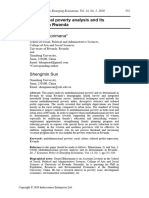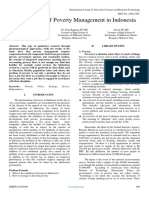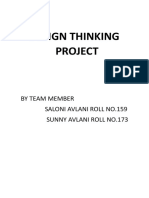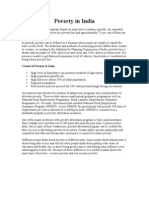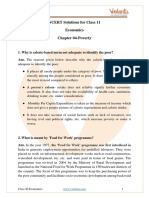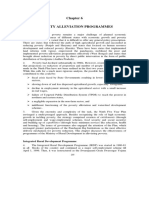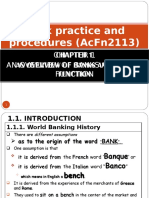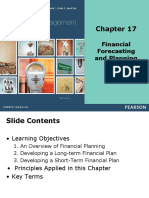Professional Documents
Culture Documents
Social Innovation For Poverty Reduction in The Special Region of Yogyakarta
Original Title
Copyright
Available Formats
Share this document
Did you find this document useful?
Is this content inappropriate?
Report this DocumentCopyright:
Available Formats
Social Innovation For Poverty Reduction in The Special Region of Yogyakarta
Copyright:
Available Formats
Volume 7, Issue 4, April – 2022 International Journal of Innovative Science and Research Technology
ISSN No:-2456-2165
Social Innovation for Poverty Reduction in the
Special Region of Yogyakarta
Rurry Andryanda1*, Muhadjir Darwin 2, Umi Listyaningsih 3, Pande Made Kutanegara4
Doctoral Program Student, Doctor of Leadership and Policy Innovation
Gajah Mada University Yogyakarta, Indonesia
Kota Yogyakarta, Jawa Tengah, Indonesia
Abstract:- The problem of poverty is one of the Affairs Regulation Number 42 of 2010 concerning
fundamental problems that are the centre of government Provincial and Regency/City Poverty Reduction
attention. One crucial aspect of supporting poverty Coordination Teams, it is stated in article 1 that poverty
reduction strategies is the availability of accurate and reduction programs are activities carried out by the
targeted poverty data. The availability of accurate government, regional governments, businesses, and the
poverty data is a must for a successful poverty reduction community to improve the welfare of the poor through
program. The problem is that the poverty data available social assistance and assistance empowerment. [2]
in Indonesia is quite diverse. This study wants to
examine the efforts to reduce poverty in Sleman Regency The development of poverty alleviation will not be
through innovations that have been carried out. The effective if it is not synergized with existing supporting
approach used is descriptive qualitative. The results programs in the regions. The economic, social, cultural,
showed that the breakthrough made by the Sleman local legal, and security fields significantly influence poverty
government has carried out social innovation with the alleviation in the area. Things that need to be considered by
Lasamba program through the stages of initiation, regions that have problems regarding poverty alleviation
development and implementation of determining include the Special Region of Yogyakarta known as DIY.
recipients of poverty programs. In addition, the Sleman Poverty and income inequality are still homework for the
Regency policy is to form a Poverty Alleviation Team DIY. Until now, the poverty rate in the DIY has reached
starting from padukuhan or hamlets to the sub-district 13.1% or the highest in Java.[1]
level, which involves elements of the government, non-
governmental organizations, and the business world. The poverty rate percentage is the highest in Java and
These efforts have shown results with a reduction in the third lowest nationally. This poverty rate also needs our
poverty rates and the accuracy of beneficiaries of attention and scrutiny regarding the poverty line standard
poverty alleviation programs in the Sleman Regency. referred to by the Central Statistics Agency (BPS/Badan
Pusat Statistik), which only uses an income standard of IDR
Keywords:- Povert; Social Innovation; poverty alleviation 360,169 per person per capita per month. With the deficient
team. standard of BPS, namely an income of IDR 360.000 per
month, the figure is 13.1%. In fact, the actual figure in the
I. INTRODUCTION field might be bigger. Besides having the highest poverty
rate in Java, the DIY also has nationally the highest income
The poverty problem is one of the fundamental inequality rate. The gap between rich and poor in the DIY is
problems that are the centre of government attention. A the highest, at 0.43 compared to the national ratio of 0.3.
critical aspect of supporting the Poverty Reduction Strategy The DIY Income Inequality Index shows that the income of
is the availability of accurate and targeted poverty data. the highest 20% of the population is more than three times
Poverty data based on the Social Protection Program Data the lowest 40% of the population. According to the World
Collection (PPLS/ Pendataan Program Perlindungan Bank, one of the essential records of success in reducing
Sosial) cannot be separated from the influence of the poverty is changing the role of the government in tackling
poverty line and the different ways of looking at poverty in poverty. Good governance is the main recipe for the success
each region in Indonesia. Poverty criteria and different of poverty reduction efforts.[3]
perspectives will lead to different interpretations of the
number of poor people, the criteria for the poor and the level Efforts to tackle poverty in the DIY have been carried
of handling of the poverty problem.[1] out, including by Sleman Regency. The Sleman Regency
Government has made the first innovation breakthrough in
The analyzed poverty data will also be used to evaluate an integrated referral service system. This system helps
government policies on poverty issues, compare poverty identify the needs of the poor and vulnerable and connects
across time and regions, and determine the target of the poor them with programs and services managed by the central,
to improve their condition through a poverty alleviation provincial, and district/city governments according to their
program. In order to implement various poverty reduction needs. This system also helps identify complaints of the
programs, information about who is poor and where they are poor and vulnerable, make referrals, and assist in handling
very important and will become the essential data in complaints to ensure that these complaints are handled
targeting poverty alleviation. For poverty reduction correctly.
programs to be successful and on target, the availability of
reliable poverty data is a necessity. The Minister of Home
IJISRT22APR499 www.ijisrt.com 373
Volume 7, Issue 4, April – 2022 International Journal of Innovative Science and Research Technology
ISSN No:-2456-2165
The second innovation is to create a one-stop service For the Development of Nutritional Status in Sleman
regarding poverty data, often referred to as an independent Regency from 2013 to 2018, the data shows that good
updating mechanism used as the basis or object of the target nutritional status tends to fluctuate up and down with a
who will benefit from the poverty alleviation program. range between 88.86% to 90.30% during the last five years.
Independent data updating is carried out from the village Meanwhile, the status of poor nutrition and
level regarding poverty data analyzed based on the PPFM undernourishment tends to decrease. The percentage of
integrated database, which contains specifications, nutritional status is more volatile and has increased in the
standards, and verification processes. This verification last 3 years. The implementation of nutritional surveillance
directly checks the object's condition of the object program activities in 2018 includes Monitoring of Nutritional Status
target to be carried out. with BB/U, TB/U, and BB/TB standards.
The third innovation in poverty alleviation carried out The potential for regional development in Sleman
in the Sleman Regency is forming a regional poverty Regency is very open. Because when viewed from all
reduction coordination team. This organization was formed regencies in the DIY, Sleman Regency is a district with the
to streamline poverty alleviation in the Sleman district highest regional income and has access to human resources
because the poverty alleviation team was formed from the and many public and private universities that can be used as
district, sub-district, village, and padukuhan or hamlets an initiator of the development of innovation in poverty
levels. This poverty alleviation team is flexible and can be alleviation. The local government of Sleman Regency can
filled by people who have expertise in poverty management collaborate between universities, the private sector, and the
involving local governments, community leaders, and the government to develop new ideas for poverty alleviation. If
private sector. these three elements can be carried out, they will be able to
create an innovation that can be the basis for formulating
The four innovation is by utilizing Corporate Social policies regarding poverty.
Responsibility funds from companies in the Sleman
Regency can be utilized by beneficiary families from The role of the government in poverty alleviation is
Program Keluarga Harapan (PKH) - which translated to the explained. First, the Regional Government is a facilitator,
Family Hope Program - to form a collaborative socio- creating conducive conditions for implementing
economic group adapted to the existing regional potential. development. Second, the Regional Government is a
The government has implemented poverty reduction regulator, preparing directions and policies. Third, the
programs since the enactment of Presidential Regulation Regional Government is a dynamist, mobilizing the
number 15 of 2010 concerning the Acceleration of Poverty participation of all elements in the community. Fourth, the
Reduction. In the new government, Presidential Regulation Regional Government is the coordinator, integrating poverty
Number 166 of 2014 was issued concerning the reduction-based programs through participatory planning
Acceleration of Poverty Reduction Program. Poverty mechanisms.
alleviation is carried out by policies by the central and
regional governments that are carried out systematically, Poverty alleviation in the regions can take advantage of
planned and in synergy between the business world and the the role of the industrial sector in supporting national
community to reduce the number of poor people to improve economic growth. The industrialization strategy plays a vital
the degree of community welfare. With the implementation role in being the main driver of economic growth and the
of Presidential Regulation Number 166 of 2014, the development of expanding job opportunities, fulfilling
government launched the Integrated Database Update. It is a people's basic needs, increasing and distributing people's
national activity aimed at ensuring the Integrated Database income, and alleviating people from poverty. UU no. 40 of
as the main component in the targeting system for poverty 2007 concerning Limited Liability Companies Article 74
reduction programs in Indonesia. This integrated database states that companies must carry out Corporate Social
displays information on socio-economic conditions. Responsibility from the company's profits. [5]
This poverty data collection becomes a reference for The poverty problem with its various characteristics is
formulating policies to reduce poverty and remembering the not easy to solve without the involvement of all elements.
urgency of providing poverty data in the regions. The The primary key to poverty reduction efforts in the regions
TKPKD or Regional Poverty Reduction Coordination Team is the establishment and institutionalization of
is a follow-up to the program. communication, coordination and cooperation networks
from the three pillars that exist in the regions: local
Things that have been done in the regional governments, communities and care groups, Non-
government's social protection efforts are a step to overcome Governmental Organizations, private sector, universities,
poverty in promoting community welfare. The flagship ulama/community leaders. The poverty problem can only be
program claimed by the government, one of which is in the overcome if the three components above work together in
Sleman district, is Program Keluarga Harapan (PKH). Data the spirit of togetherness and participate in finding
on health facilities in Sleman Regency in 2018, PKH alternative poverty criteria, poverty data collection,
recipients experienced an increase from an average of targeting, problem-solving, and poverty reduction efforts to
56,909 KPM from 65,501 KPM who visited health be more objective and on target.
facilities.[4]
IJISRT22APR499 www.ijisrt.com 374
Volume 7, Issue 4, April – 2022 International Journal of Innovative Science and Research Technology
ISSN No:-2456-2165
The facts on the ground show that the poverty II. METHODS
reduction policies carried out so far still have many
weaknesses in poverty reduction policies. Government This research used a qualitative approach in the form
policies based on experience in poverty alleviation have of a case study which is a research strategy that requires
several weaknesses. They are (1) still oriented towards researchers to carefully investigate a program, event,
macro growth without paying attention to the aspect of activity, process, or group of individuals. [6] The method used
equity, (2) policies that are centralized, (3) more caricative was the case study method as presented. [7] Case studies were
than transformative, (4) positioning society as an object used as a comprehensive explanation relating to various
rather than a subject, (5) an orientation towards poverty aspects of a person, a group, an organization, a program, or
alleviation that tends to be creative and momentary rather a social situation being researched, sought and studied as
than sustainable productivity, and (6) a generic perspective profoundly as possible. This research was conducted in the
and solution to the existing poverty problem without paying Sleman Regency, The Special Region of Yogyakarta. This
attention to the existing plurality (Multifiah, 2011). Due to regency is bordered by Central Java Province in the north
the varied nature of the challenges, the handling of the and east, Gunung Kidul Regency, Bantul Regency and
poverty problem must touch the actual source and root of Yogyakarta City in the south, and Kulon Progo Regency in
the problem, either directly or indirectly. the west.
In understanding poverty in the Sleman Regency, it is Data collection techniques were carried out using
essential to pay attention to the locality in each region, observation, interviews and documentation studies.
namely poverty at the local level determined by the Observations are carried out by systematically observing
community and local government. The implementation of and recording the symptoms that appear on the object of
the poverty reduction program aims to improve the welfare observation research, divided into two, namely direct and
of the poor from two sides. First, increasing income by indirect observations. Meanwhile, interviews in this study
increasing productivity so that the poor can manage, obtain were conducted when collecting information that was not
opportunities, and protect to obtain better works in various obtained from observation. The key informants in this
economic, social, cultural, and political activities. Second, research interview were the regent and deputy regent,
poverty reduction reduces the burden of basic needs such as regional secretary, head of social services, head of the
access to education, health, and infrastructure that facilitates Regional Planning Agency, head of BPS Sleman and
and supports socio-economic activities. For this reason, members of the Regional People's Representative Council.
strategic steps are needed to accelerate poverty reduction After the observations and interviews were carried out, the
and build partnerships between various sectors in the next step was to study documentation which is a technique
Sleman Regency. of collecting data and analyzing documents, whether
written, illustrated, or electronically.[8]
Data analysis was carried out after primary and
secondary data had been collected. The next step was
preparing and organizing the data (text data such as
transcripts or image data such as photographs) for analysis,
then reducing the data into themes through the process of
coding and summarizing the code and finally presenting the
data in the form of a chart, table or discussion. Qualitative
data analysis techniques are data reduction, data
presentation and conclusion drawing. This process continues
throughout the research, even before the data is collected. [9]
III. RESULT
Tahun Number of Poor population (000) Percentage of Poor Population
2016 96,63 8,21
2017 96,75 8,13
2018 92,04 7,65
2019 90,17 7,41
2020 99,78 8,12
Table 1: Number and Percentage of Poor Population in Sleman Regency March 2016 - March 2020
Source: Susenas March 2016 – March 2020
IJISRT22APR499 www.ijisrt.com 375
Volume 7, Issue 4, April – 2022 International Journal of Innovative Science and Research Technology
ISSN No:-2456-2165
Table 1 shows the number of poor population in the number of poor people in this Regency by 9.61 thousand
Sleman Regency from March 2016 to March 2020. Poverty people or an increase of 10.65 percent.
conditions in this Regency during this period were quite
volatile, but in the last year, there was a significant increase. The percentage of the poor population in the Sleman
From the results of the Susenas in March 2020, the poor Regency in 2020 has increased after experiencing a decline
population in the Sleman Regency is 99.78 thousand people. in recent years. In March 2020, the percentage of the poor
Compared with the results of the Susenas in March 2019, was recorded at 8.12 percent, an increase of 0.71 percentage
where the number of poor people at that time was 90.17 points compared to the condition in the previous year, which
thousand people, this condition showed an increase in the was recorded at 7.41 percent (March 2019).
Fig. 2: Number of Poor Population in Sleman Regency March 2016 - March 2020 (in thousands of people)
Source: Susenas March 2016 - March 2020
During the period March 2016 - March 2019, the experienced a reasonably high increase to 99.78 thousand
poverty situation in this Regency tends to improve (Figure people.
2). In March 2016, the poor population was recorded at
96.63 thousand people. This number continued to In the last five years, the poverty rate in the Sleman
experience a downward trend until 2019, although it rose Regency has fluctuated with a downward trend until 2019
slightly in 2017. In March 2020, the poor population and increased in 2020, as is shown in Figure 3.
Fig. 3: Percentage of Poor Population in the Sleman Regency March 2016 – March 2020
Source: Susenas March 2016 - March 2020
From March 2016 to March 2019, the percentage of target. After the 1998 economic crisis, the Indonesian
the poor population in the Sleman Regency decreased from government began designing and implementing various
8.21 percent to 7.41 percent. During this period, the poverty programs specifically aimed at the poor. The government at
percentage continued to decline. In March 2020, the that time launched Program Jaringan Pengaman Sosisal
percentage of the poor population rose to 8.12 percent. (JPS)– which translated to the Social Safety Net Program,
which aimed to protect the fields of food, health, education,
IV. DISCUSSION and access to sources of income for people who were
already poor before the economic crisis, and people who
A. Social Innovation for Poverty Reduction in the Special became poor due to the impact of the economic crisis.
Region of Yogyakarta Among the various JPS programs, the highest target number
The Social Innovation process for poverty alleviation in of participants/beneficiaries are the rice subsidy program for
the Sleman Regency is divided into 3 stages, namely the poor households (originally called Special Market
initiation stage, the development stage and the Operations or OPK, later became the Raskin Program) and
implementation stage. Health Assistance known as JPS-BK. The target
participants/beneficiaries of these programs are Pre-
Social innovation aims to solve the problems that the Prosperous and Prosperous Families-1 based on the National
community faces so that what is meant by better is the Family Planning Coordinating Board or BKKBN. The
condition of the community, which is the beneficiaries' Regional Empowerment Program in Overcoming the Impact
IJISRT22APR499 www.ijisrt.com 376
Volume 7, Issue 4, April – 2022 International Journal of Innovative Science and Research Technology
ISSN No:-2456-2165
of the Economic Crisis (PDMDKE) is a program of structured poverty reduction programs. The poverty
assistance from the government in revolving credit funds reduction program is divided into four clusters. Cluster 1 is a
intended for the poor and unemployed due to the 1997-1998 group of aid and social protection-based poverty reduction
economic crisis. The target groups in this program are programs to fulfil fundamental rights, reduce the burden of
households belonging to the Pre-Prosperous Family, life, and improve the quality of life of the poor. Then,
Prosperous Family 1, and the unemployed. Assistance funds cluster 2 is a group of community empowerment-based
are given to almost every village in Indonesia. With the poverty reduction programs. After that, cluster 3 is a group
amount of the funds adjusted to the size of the village of poverty reduction programs based on the empowerment
concerned. The aid funds can be used for physical of micro and small economic enterprises. The last, cluster 4
development activities and productive economic activities. is a group of pro-people programs.
Several social protection programs in the 2000s era In 2011, BPS conducted PPLS (PPLS, 2011) again by
were quite popular, including the School Operational taking advantage of the momentum of the 2010 Population
Assistance program], known as BOS, in the Education Census, which is an update of Indonesia's population data as
sector, which assisted in operational funds for schools in a whole. The main objective of PPLS 2011 is to develop an
Indonesia. In the health sector, there is a health insurance Integrated Database for social protection programs.
program called Health Insurance for the Poor –known as
askeskin, which later transformed into the Community Although various efforts have been made to reduce
Health Insurance Program, known as jamkesmas, then poverty and vulnerability, the number of poor and
became Contribution Assistance Recipients (PBI) of the vulnerable people remains high. The Central Statistics
National Health Insurance System (JKN). There is the Agency recorded that the number of poor people in March
Subsidized Rice program for Low-Income Communities in 2017 was 27.77 million people or approximately 10.64%. In
the food sector, which results from a change from the addition, people above the poverty line are vulnerable to
previous program, Special Market Operations or OPK. The falling into poverty if they face an economic shock or crisis.
government also provided direct assistance in the form of The income distribution gap is also widening, and the
cash as compensation for the poor for the increase in the increase can see in Indonesia's Gini ratio from 0.35 in 2009
price of fuel oil in 2005 and 2009. This program was known to 0.393 in March 2017. Likewise, the gap between rural
as the Direct Cash Assistance program or BLT program, and urban areas is still high. In March 2017, poor people in
which later changed to Community Temporary Assistance rural areas were 13.93%, higher than 7.72% in urban areas.
(BLSM) when the fuel price hike happened again in 2013. Many poor and vulnerable families do not receive
comprehensive social protection services despite being
In 2005, through BPS, the government conducted eligible for assistance.
Socio-Economic Data Collection (PSE 2005). The main
objective of PSE 2005 is to identify target households Services and handling of social problems that have not
receiving BLT Program as compensation for the reduction been optimal stems from the lack of integration in the
in fuel subsidies. However, in addition to the BLT program, implementation of social services. Many sectoral service
PSE 2005 data was also used for targeting askeskin programs are still running, following each institution's main
program, which was later known as the Community Health tasks and functions independently. Law Number 11 of 2009
Insurance or jamkesmas and the Raskin Program. has mandated that the implementation of social welfare
carried out by the central and regional governments and the
In 2008, to distribute the BLT Program, BPS as the community must be directed, sustainable, and integrated.
person in charge of providing data on the target households
receiving BLT, conducted a household socio-economic data In the Sleman Regency, ways to overcome poverty are
collection known as the Social Protection Program Data developed in various, more comprehensive ways. In 2008,
Collection (PPLS, 2008). The primary data for PPLS 2008 is the first generation poverty information system was
PSE 2005 data which was updated with verification results developed based on the regulation of the Sleman regent
in 1,023 sub-districts in 97 regencies/cities in 15 provinces number 21 to map low-income families in receiving poverty
in the pilot area of the Family Hope Program; that is, the programs with fourteen poverty indicators. After
final result was 19,018,057 targeted households. The implementing the poverty information system and
ranking of household welfare status based on the 2008 PPLS developing it better in terms of scope and usability, in 2009,
still uses the RTSM, RTM, and RTHM classifications. a second-generation poverty information system was formed
Unlike the PSE 2005, the PPLS 2008 uses 14 household until 2012; this second-generation poverty system can
variables in the PSE 2005 plus 8 individual variables survive after experiencing two generations of poverty in the
(household members), and the Proxy Means Testing model Sleman district. The local government has a shared passion
to determine the ranking of the household welfare status for building a complete data system. Every relevant agency
being recorded. with a poverty alleviation program can provide programs to
beneficiary families to be right on target.
In 2010, the National Team for the Acceleration of
Poverty Reduction (TNP2K) was established as a forum for After experiencing changes in the poverty system of
cross-sectoral and cross-stakeholder coordination at the the first and second generations, the Sleman local
national level to accelerate poverty reduction. Through government is trying to combine regional poverty data with
TNP2K, the government has begun implementing more poverty data that the centre has carried out through data
IJISRT22APR499 www.ijisrt.com 377
Volume 7, Issue 4, April – 2022 International Journal of Innovative Science and Research Technology
ISSN No:-2456-2165
collection on social protection programs, better known as The management of the Sembada SLRT at the Social
PPLS 2011. After receiving PPLS 2011 data from the Service Office of the Sleman Regency since the beginning
central government, the regional poverty system was of its growth in late 2016 has been strongly supported by
redeveloped in 2013. Services and handling of social relevant agencies, such as Bappeda, Diskominfo, Health
problems which has not been optimal stems from the lack of Office and other agencies. Regarding budget support, the
integration in the implementation of social services. Many implementation of the SLRT in the Sleman Regency is
sectoral service programs are still running, following each strongly supported by the Sleman Regency budget team.
institution's main tasks and functions independently. Law One of the SLRT managers comes from Bappeda, so
Number 11 of 2009 has mandated that the implementation information on the implementation and benefits of SLRT
of social welfare carried out by the central and regional can already be known directly by themselves as the activity
governments and the community must be directed, and budget planner. During the Covid-19 pandemic, the
sustainable, and integrated. SLRT budget also experienced a budget reallocation, but it
did not affect the services and referrals provided by the
Local governments have a mandate to provide essential SLRT Sembada Social Service of Sleman Regency.
services to improve people's welfare. Local governments
also have sufficient resources to implement social protection Handling social problems is very complex and requires
and poverty reduction programs, both from central transfers innovative ways to handle them quickly and precisely. In
and local revenue. However, the authority and magnitude of Sleman Regency, the handling of social problems is carried
these resources are not matched by adequate capacity in out with an approach adapted to the regional motto called
managing social protection programs and poverty alleviation SEMBADA, which stands for Smile, Empathy, Serving,
and are currently better known as SLRT. SLRT is a service Sharing, Dedicated, Trustworthy, Disciplined and
system that helps identify the needs of the poor and Accountable. Problems often encountered in the Sleman
vulnerable poor and connects them with social protection Regency include health and education, all of which lead to
programs2 and poverty reduction 3 organized by the poverty. With the problems faced, innovations are needed
government, both central, provincial, and district/city that can support solving these problems. To make it happen,
governments according to their needs. The SLRT also helps the Sleman district carried out an innovation program called
identify complaints from the poor and vulnerable to the LASAMBA (sambaing citizen service).
poor, make referrals, and monitor complaints to ensure that
these complaints are handled correctly. The objective of The Lasamba program is from the Sleman Regency
SLRT is to increase the effectiveness and efficiency of Social Service, which was officially launched on 27-08-
social protection systems to reduce poverty, vulnerability 2018 in padukuhan Sembung, Sukoharjo Ngaglik Sleman. It
and inequality. is an innovation from the Social Service of Sleman Regency
that used a ball pick-up system. It means that the
In connection with this, the concept of implementing government will go directly to visit residents to realize the
the Integrated Service and Referral System in Sleman quality of improving the quality of the public, especially for
Regency is to place the Sembada SLRT secretariat at the underprivileged residents who need social services and
Sleman Regency Social Service as the gateway for social social assistance without having to apply first to the
services and complaints at the Social Service. Following the Department of Social Affairs. To support this program, in
needs of residents who come to complain and ask for social providing public services to the community, this program is
services that continue to develop and require appropriate supported by the quick reaction team and 25 personnel from
and fast solutions, the Sleman District Social Service also District Social Welfare staff (TKSK), Community Social
prepares support, both from regulatory support, budget and Workers (PSM) and PKH Facilitator so the program can be
human resources that can meet the needs of the community. faster and more complete. The Lasamba program has
In the national priority for poverty reduction in 2018, the changed the service system from one direction to two. This
government focuses on accelerating poverty reduction and program is an essential part of the bureaucratic culture to be
equitable growth for the lowest 40% of the population. This more responsive to the community's needs, so it does not
effort is carried out by implementing targeted social security wait but picks up and solves residents' problems. Currently,
and assistance programs, meeting basic needs, and there are approximately 77 residents served by the Lasamba
expanding access to micro, small and cooperative program.[10]
enterprises.
V. CONCLUSION
The following human resources support the
implementation of the Sembada SLRT in the Sleman Based on the results of research and analysis, it can be
Regency. The SLRT managers are 3 people from Social concluded that alleviating poverty in the Sleman area has
Service, Development Planning Agency (Bappeda), and resulted in innovation in the form of citizen sambaing
Regional Research and Development, Communication and services or the Lasamba program. This method used a
Information Office (Diskominfo), 11 back office officers regional approach to reach people who need social
(all structural officials of Social Service become SLRT back assistance. The Regional Government of Sleman Regency
office officers), 8 front office officers, 3 Ngantar Paimah has formed a poverty alleviation team to the village level
officers, 25 Lasamba officers, 17 SLRT supervisors (1 and has a complaint service regarding the poverty program.
subdistrict one supervisor) and 86 SLRT facilitators in 86
villages throughout the Sleman Regency.
IJISRT22APR499 www.ijisrt.com 378
Volume 7, Issue 4, April – 2022 International Journal of Innovative Science and Research Technology
ISSN No:-2456-2165
REFERENCES
[1.] BPS DIY. 2018. Tingkat Ketimpangan Pengeluaran
Penduduk Daerah Istimewa Yogyakarta Maret 2018
Meningkat. Badan Pusat Statistik Daerah Istimewa
Yogyakarta.
[2.] Peraturan Menteri Dalam Negeri Republik Indonesia
Nomor 42 Tahun 2010 tentang Tim Koordinasi
Penanggulangan Kemiskinan Provinsi dan Kabupaten /
Kota.
[3.] Bank Dunia. 2017. Making The New Indonesia wok for
the poor. Jakarta.
[4.] Dinas Kesehatan DIY. (2018). Profil Kesehatan Dinas
Kesehatan Provinsi Daerah Istimewa Yogyakarta
Tahun 2018. Dinas Kesehatan Daerah Istimewa
Yogyakarta.
[5.] Untung, H.B, 2018, Corporateelmet Social
Responsibility, Jakarta, Sinar Grafika.
[6.] Creswell, J. W., & Poth, C. N. (2018). Qualitative
Inquiry and Research Design Choosing Among Five
Approaches (4th Edition ed.). California: Sage
Publishing.
[7.] Yin, Robert K.2018. Studi Kasus: Desain dan Metode.
Depok. Rajawali Press.
[8.] Rizki Yudha Bramantyo. 2021. Pemetaan Kemiskinan
Dengan Pendekatan Lingkungan Sebagai Tahapan
Pengentasan Kemiskinandi Kota Kediri. Jispar, Jurnal
Ilmu Sosial, Politik Dan Pemerintahan. Volume 10
Issue 1.
[9.] Wahyuddin, Ar Royyan Ramly, Muslim A. Djalil &
Mirna Indriani. 2019. Fektivitas Pemanfaatan Dana
Desa Dalam Mengentaskan Kemiskinan Di Kec Kuala
Kabupaten Nagan Raya. Jurnal Penelitian Ilmu Sosial
Dan Kegamaan Islam Vol. 16 No. 2 Juli – Desember
2019.
[10.] Fithriyatul Inayah. 2020. Agenda Setting Lasamba
(Layanan Sambang Warga) Dalam Meningkatkan
Kesejahteraan Masyarakat Kabupaten Sleman Tahun
2019. Universitas Muhammadiyah Yogyakarta:
Yogyakarta.
IJISRT22APR499 www.ijisrt.com 379
You might also like
- Efektivitas Pelaksanaan Program Bantuan Sosial Pada Masyarakat Di Kota Palu (Studi Tentang Kelompok Usaha Bersama)Document8 pagesEfektivitas Pelaksanaan Program Bantuan Sosial Pada Masyarakat Di Kota Palu (Studi Tentang Kelompok Usaha Bersama)Surya SemestaNo ratings yet
- The Effect of Poverty On Development Growth in Sidoarjo RegencyDocument8 pagesThe Effect of Poverty On Development Growth in Sidoarjo RegencyOpen Access JournalNo ratings yet
- Policy Implementation of Family Hope Program in Labuhanbatu DistrictDocument12 pagesPolicy Implementation of Family Hope Program in Labuhanbatu DistrictPutri IcaNo ratings yet
- Impact of Harapan Family Program on Poor HouseholdsDocument8 pagesImpact of Harapan Family Program on Poor HouseholdsNikmah Abidah TelaumbanuaNo ratings yet
- Implementation of The Farmer's Empowerment ProgramDocument7 pagesImplementation of The Farmer's Empowerment ProgramyanuarydwipNo ratings yet
- Poverty Alleviation Programmes in India: A Social Audit: Review ArticleDocument10 pagesPoverty Alleviation Programmes in India: A Social Audit: Review ArticlekowsilaxNo ratings yet
- Abdul Halim ISKANDAR1 Achmad Faidy SUJA'IE2 Ivanovich AGUSTADocument20 pagesAbdul Halim ISKANDAR1 Achmad Faidy SUJA'IE2 Ivanovich AGUSTAsyaifur rahmanNo ratings yet
- Project ProposalDocument11 pagesProject Proposalmokarrom topuNo ratings yet
- Dissertation On Poverty in IndiaDocument7 pagesDissertation On Poverty in IndiaBestWriteMyPaperWebsiteClarksville100% (1)
- 2375-Article Text-6838-1-10-20221002Document9 pages2375-Article Text-6838-1-10-20221002Intan PurnamasariNo ratings yet
- Sustainable Entrepreneurial Livelihood PDocument5 pagesSustainable Entrepreneurial Livelihood PRyan GañaNo ratings yet
- 5079 15744 2 PBDocument18 pages5079 15744 2 PBAli AkbarNo ratings yet
- Role of NGOs in rural developmentDocument9 pagesRole of NGOs in rural developmentanaNo ratings yet
- Policy Implementation On of Poverty Alleviationin Bandung City, West Java, IndonesiaDocument6 pagesPolicy Implementation On of Poverty Alleviationin Bandung City, West Java, IndonesiaCintaNo ratings yet
- D5 C1 G1 1Document7 pagesD5 C1 G1 1Mariah Fatima AdobasNo ratings yet
- Regional Economic Development Based On Local PotentialDocument9 pagesRegional Economic Development Based On Local PotentialrindueuropeNo ratings yet
- The Strategy To Solve Poverty Problem in Indonesia: By: Muh. ArdiansyahDocument15 pagesThe Strategy To Solve Poverty Problem in Indonesia: By: Muh. ArdiansyahMuhammad ArdiansyahNo ratings yet
- Law and Poverty AssignmentDocument9 pagesLaw and Poverty Assignmentpriyanshu10029No ratings yet
- IJMIEapril19 SuchiIJMRADDocument9 pagesIJMIEapril19 SuchiIJMRADnehaNo ratings yet
- 805-Research Results-1387-1-10-20210417Document17 pages805-Research Results-1387-1-10-20210417sddNo ratings yet
- Poverty Eradication and The Role of NGO in BangladeshDocument7 pagesPoverty Eradication and The Role of NGO in BangladeshZaki AhmadNo ratings yet
- Implementasi Kebijakan Penanggulangan Kemiskinan Melalui Program Keluarga Harapan Di Kecamatan Tamalate Kota MakassarDocument9 pagesImplementasi Kebijakan Penanggulangan Kemiskinan Melalui Program Keluarga Harapan Di Kecamatan Tamalate Kota Makassaryuly klauNo ratings yet
- ID Studi Penanggulangan Kemiskinan KomunitaDocument15 pagesID Studi Penanggulangan Kemiskinan KomunitaBell ArmiaNo ratings yet
- 3872 14449 2 PBDocument14 pages3872 14449 2 PBSadrakh Andreas Maynard HalohoNo ratings yet
- SAI and EAP - Governing Village Fund in IndonesiaDocument14 pagesSAI and EAP - Governing Village Fund in IndonesiaEsti AfriNo ratings yet
- Poverty ReductionDocument12 pagesPoverty Reductionবিজয় সিকদারNo ratings yet
- Microcredit's Role in Poverty Alleviation in Rural BangladeshDocument68 pagesMicrocredit's Role in Poverty Alleviation in Rural BangladeshJakaria KhanNo ratings yet
- Model Development of Community Participation in Post Implementation of Village Development Act Number6:2014 in Megaluh Village, Jombang Regency, East Java ProvinceDocument10 pagesModel Development of Community Participation in Post Implementation of Village Development Act Number6:2014 in Megaluh Village, Jombang Regency, East Java ProvinceAndala Rama P BarusmanNo ratings yet
- Best Practices 17 Social Security State-Wise InitiativesDocument13 pagesBest Practices 17 Social Security State-Wise InitiativesPrajyot MashaleNo ratings yet
- PovertyDocument11 pagesPovertyShivansh SinghNo ratings yet
- The Relationship Between State and Society: Managing Poverty Through Local WisdomDocument10 pagesThe Relationship Between State and Society: Managing Poverty Through Local WisdomDewa Made AgungNo ratings yet
- PovertyDocument10 pagesPovertyapi-545518030No ratings yet
- Bikorimana2020 - Probit RegressionDocument30 pagesBikorimana2020 - Probit RegressionNahid Md. AlamNo ratings yet
- Poverty Measuring AntiPoverty Policies and The Relationship of Philippine Economy To Social InequalityDocument10 pagesPoverty Measuring AntiPoverty Policies and The Relationship of Philippine Economy To Social InequalityArrabella A. De MesaNo ratings yet
- Effectiveness of Poverty Management in IndonesiaDocument7 pagesEffectiveness of Poverty Management in IndonesiaInternational Journal of Innovative Science and Research TechnologyNo ratings yet
- ChapterDocument96 pagesChapterIshwar singh DhamiNo ratings yet
- Design Thinking Project Saloni Sunny C - PPTDocument12 pagesDesign Thinking Project Saloni Sunny C - PPTSunny AvlaniNo ratings yet
- Poverty Project For KD SIR.... BMSDocument5 pagesPoverty Project For KD SIR.... BMSManasvi DawdaNo ratings yet
- Evaluation of The Non-Cash Food Assistance Program in Poverty Alleviation in Enrekang RegencyDocument8 pagesEvaluation of The Non-Cash Food Assistance Program in Poverty Alleviation in Enrekang RegencyInternational Journal of Innovative Science and Research TechnologyNo ratings yet
- Review JurnalDocument11 pagesReview JurnalYusniar MustajNo ratings yet
- Res+Militaris Engkus Pusat+PAYMENTDocument13 pagesRes+Militaris Engkus Pusat+PAYMENTMenma Uchiha Sumātona Kodomo-tachiNo ratings yet
- Pengaruh Program Simpan Pinjam Kelompok Perempuan Terhadap Pendapatan Usahamikro Kecil Dan PovertyDocument24 pagesPengaruh Program Simpan Pinjam Kelompok Perempuan Terhadap Pendapatan Usahamikro Kecil Dan PovertyHana Michiko UsagiNo ratings yet
- Class 11 Indian Economic Development - Chapter 4Document8 pagesClass 11 Indian Economic Development - Chapter 4Raghuveer Singh ranaNo ratings yet
- Rahayurelawati, Nuryitmawan English VersionDocument14 pagesRahayurelawati, Nuryitmawan English Versionbangun JihadNo ratings yet
- EBU 1033 Russell Floyd Albert (81069) IADocument7 pagesEBU 1033 Russell Floyd Albert (81069) IARussell FloydNo ratings yet
- Poverty in IndiaDocument7 pagesPoverty in IndiaEram FatmaNo ratings yet
- Poverty Alleviation Policies StrategiesDocument5 pagesPoverty Alleviation Policies StrategiesBRITTANY STANLEYNo ratings yet
- Integrated Rural Development ProgrammeDocument26 pagesIntegrated Rural Development ProgrammeJenica SharuNo ratings yet
- Model Pengendalian Kemiskinan Dengan Pendekatan Diversifikasi UsahaDocument19 pagesModel Pengendalian Kemiskinan Dengan Pendekatan Diversifikasi UsahaNever MoreNo ratings yet
- Managerial Accounting PresentationDocument24 pagesManagerial Accounting PresentationAlamin tahaminNo ratings yet
- The Role of The Dumai City Government in The Use of Reducing PovertyDocument12 pagesThe Role of The Dumai City Government in The Use of Reducing PovertyInternational Journal of Innovative Science and Research TechnologyNo ratings yet
- Reducing Poverty in Nigeria Through Home Economics EducationDocument23 pagesReducing Poverty in Nigeria Through Home Economics EducationCyril Justus Ekpo0% (1)
- Pola Konsumsi Dan Ketimpangan Ekonomi Masyarakat Miskin Penerima Program Keluarga Harapan (PKH) Kabupaten SemarangDocument11 pagesPola Konsumsi Dan Ketimpangan Ekonomi Masyarakat Miskin Penerima Program Keluarga Harapan (PKH) Kabupaten Semarangfanisha andaristaNo ratings yet
- Impact of Government-Non Government Programmes On Livelihood of The Beneficiaries of Bhedarganj Upazila at Shariatpur District in BangladeshDocument10 pagesImpact of Government-Non Government Programmes On Livelihood of The Beneficiaries of Bhedarganj Upazila at Shariatpur District in BangladeshInternational Journal of Innovative Science and Research TechnologyNo ratings yet
- Ap 18Document5 pagesAp 18Anitha PeyyalaNo ratings yet
- Ucsp 1Document23 pagesUcsp 1Jesierine GarciaNo ratings yet
- Analysis of The Effect of Tax Revenue On Poverty Rates in Indonesia in 2019 - 2020Document11 pagesAnalysis of The Effect of Tax Revenue On Poverty Rates in Indonesia in 2019 - 2020QARRA SALMA SETIAWANNo ratings yet
- 7796 28794 1 SMDocument9 pages7796 28794 1 SMNahdia Khoerun NisaNo ratings yet
- Reaching the Sustainable Development Goals Through Better Local-Level Data: A Case Study on Lumajang and Pacitan Districts in IndonesiaFrom EverandReaching the Sustainable Development Goals Through Better Local-Level Data: A Case Study on Lumajang and Pacitan Districts in IndonesiaNo ratings yet
- Improvement Functional Capacity In Adult After Percutaneous ASD ClosureDocument7 pagesImprovement Functional Capacity In Adult After Percutaneous ASD ClosureInternational Journal of Innovative Science and Research TechnologyNo ratings yet
- Machine Learning and Big Data Analytics for Precision Cardiac RiskStratification and Heart DiseasesDocument6 pagesMachine Learning and Big Data Analytics for Precision Cardiac RiskStratification and Heart DiseasesInternational Journal of Innovative Science and Research TechnologyNo ratings yet
- Optimization of Process Parameters for Turning Operation on D3 Die SteelDocument4 pagesOptimization of Process Parameters for Turning Operation on D3 Die SteelInternational Journal of Innovative Science and Research TechnologyNo ratings yet
- Design and Implementation of Homemade Food Delivery Mobile Application Using Flutter-FlowDocument7 pagesDesign and Implementation of Homemade Food Delivery Mobile Application Using Flutter-FlowInternational Journal of Innovative Science and Research TechnologyNo ratings yet
- Enhancing Biometric Attendance Systems for Educational InstitutionsDocument7 pagesEnhancing Biometric Attendance Systems for Educational InstitutionsInternational Journal of Innovative Science and Research TechnologyNo ratings yet
- Forensic Evidence Management Using Blockchain TechnologyDocument6 pagesForensic Evidence Management Using Blockchain TechnologyInternational Journal of Innovative Science and Research TechnologyNo ratings yet
- Food habits and food inflation in the US and India; An experience in Covid-19 pandemicDocument3 pagesFood habits and food inflation in the US and India; An experience in Covid-19 pandemicInternational Journal of Innovative Science and Research TechnologyNo ratings yet
- Late Presentation of Pulmonary Hypertension Crisis Concurrent with Atrial Arrhythmia after Atrial Septal Defect Device ClosureDocument12 pagesLate Presentation of Pulmonary Hypertension Crisis Concurrent with Atrial Arrhythmia after Atrial Septal Defect Device ClosureInternational Journal of Innovative Science and Research TechnologyNo ratings yet
- Scrolls, Likes, and Filters: The New Age Factor Causing Body Image IssuesDocument6 pagesScrolls, Likes, and Filters: The New Age Factor Causing Body Image IssuesInternational Journal of Innovative Science and Research TechnologyNo ratings yet
- Severe Residual Pulmonary Stenosis after Surgical Repair of Tetralogy of Fallot: What’s Our Next Strategy?Document11 pagesSevere Residual Pulmonary Stenosis after Surgical Repair of Tetralogy of Fallot: What’s Our Next Strategy?International Journal of Innovative Science and Research TechnologyNo ratings yet
- The Students’ Assessment of Family Influences on their Academic MotivationDocument8 pagesThe Students’ Assessment of Family Influences on their Academic MotivationInternational Journal of Innovative Science and Research Technology100% (1)
- Blockchain-Enabled Security Solutions for Medical Device Integrity and Provenance in Cloud EnvironmentsDocument13 pagesBlockchain-Enabled Security Solutions for Medical Device Integrity and Provenance in Cloud EnvironmentsInternational Journal of Innovative Science and Research TechnologyNo ratings yet
- A Review on Process Parameter Optimization in Material Extrusion Additive Manufacturing using ThermoplasticDocument4 pagesA Review on Process Parameter Optimization in Material Extrusion Additive Manufacturing using ThermoplasticInternational Journal of Innovative Science and Research TechnologyNo ratings yet
- Quality By Plan Approach-To Explanatory Strategy ApprovalDocument4 pagesQuality By Plan Approach-To Explanatory Strategy ApprovalInternational Journal of Innovative Science and Research TechnologyNo ratings yet
- Design and Development of Controller for Electric VehicleDocument4 pagesDesign and Development of Controller for Electric VehicleInternational Journal of Innovative Science and Research TechnologyNo ratings yet
- Administration Consultancy Administrations, a Survival Methodology for Little and Medium Undertakings (SMEs): The Thailand InvolvementDocument4 pagesAdministration Consultancy Administrations, a Survival Methodology for Little and Medium Undertakings (SMEs): The Thailand InvolvementInternational Journal of Innovative Science and Research TechnologyNo ratings yet
- The Experiences of Non-PE Teachers in Teaching First Aid and Emergency Response: A Phenomenological StudyDocument89 pagesThe Experiences of Non-PE Teachers in Teaching First Aid and Emergency Response: A Phenomenological StudyInternational Journal of Innovative Science and Research TechnologyNo ratings yet
- Targeted Drug Delivery through the Synthesis of Magnetite Nanoparticle by Co-Precipitation Method and Creating a Silica Coating on itDocument6 pagesTargeted Drug Delivery through the Synthesis of Magnetite Nanoparticle by Co-Precipitation Method and Creating a Silica Coating on itInternational Journal of Innovative Science and Research TechnologyNo ratings yet
- Gardening Business System Using CNN – With Plant Recognition FeatureDocument4 pagesGardening Business System Using CNN – With Plant Recognition FeatureInternational Journal of Innovative Science and Research TechnologyNo ratings yet
- Anxiety, Stress and Depression in Overseas Medical Students and its Associated Factors: A Descriptive Cross-Sectional Study at Jalalabad State University, Jalalabad, KyrgyzstanDocument7 pagesAnxiety, Stress and Depression in Overseas Medical Students and its Associated Factors: A Descriptive Cross-Sectional Study at Jalalabad State University, Jalalabad, KyrgyzstanInternational Journal of Innovative Science and Research Technology90% (10)
- Investigating the Impact of the Central Agricultural Research Institute's (CARI) Agricultural Extension Services on the Productivity and Livelihoods of Farmers in Bong County, Liberia, from 2013 to 2017Document12 pagesInvestigating the Impact of the Central Agricultural Research Institute's (CARI) Agricultural Extension Services on the Productivity and Livelihoods of Farmers in Bong County, Liberia, from 2013 to 2017International Journal of Innovative Science and Research TechnologyNo ratings yet
- Databricks- Data Intelligence Platform for Advanced Data ArchitectureDocument5 pagesDatabricks- Data Intelligence Platform for Advanced Data ArchitectureInternational Journal of Innovative Science and Research TechnologyNo ratings yet
- Comparison of Lateral Cephalograms with Photographs for Assessing Anterior Malar Prominence in Maharashtrian PopulationDocument8 pagesComparison of Lateral Cephalograms with Photographs for Assessing Anterior Malar Prominence in Maharashtrian PopulationInternational Journal of Innovative Science and Research TechnologyNo ratings yet
- Development of a Local Government Service Delivery Framework in Zambia: A Case of the Lusaka City Council, Ndola City Council and Kafue Town Council Roads and Storm Drain DepartmentDocument13 pagesDevelopment of a Local Government Service Delivery Framework in Zambia: A Case of the Lusaka City Council, Ndola City Council and Kafue Town Council Roads and Storm Drain DepartmentInternational Journal of Innovative Science and Research TechnologyNo ratings yet
- Optimizing Sound Quality and Immersion of a Proposed Cinema in Victoria Island, NigeriaDocument4 pagesOptimizing Sound Quality and Immersion of a Proposed Cinema in Victoria Island, NigeriaInternational Journal of Innovative Science and Research TechnologyNo ratings yet
- Examining the Role of Work-Life Balance Programs in Reducing Burnout among Healthcare Workers: A Case Study of C.B. Dunbar Hospital and the Baptist Clinic in Gbarnga City, Bong County, LiberiaDocument10 pagesExamining the Role of Work-Life Balance Programs in Reducing Burnout among Healthcare Workers: A Case Study of C.B. Dunbar Hospital and the Baptist Clinic in Gbarnga City, Bong County, LiberiaInternational Journal of Innovative Science and Research TechnologyNo ratings yet
- Digital Pathways to Empowerment: Unraveling Women's Journeys in Atmanirbhar Bharat through ICT - A Qualitative ExplorationDocument7 pagesDigital Pathways to Empowerment: Unraveling Women's Journeys in Atmanirbhar Bharat through ICT - A Qualitative ExplorationInternational Journal of Innovative Science and Research TechnologyNo ratings yet
- Chemical Farming, Emerging Issues of Chemical FarmingDocument7 pagesChemical Farming, Emerging Issues of Chemical FarmingInternational Journal of Innovative Science and Research TechnologyNo ratings yet
- Post-Treatment Effects of Multiple Sclerosis (MS) on the Executive and Memory Functions ofCommercial Pilots in the UAEDocument7 pagesPost-Treatment Effects of Multiple Sclerosis (MS) on the Executive and Memory Functions ofCommercial Pilots in the UAEInternational Journal of Innovative Science and Research TechnologyNo ratings yet
- Impact of Quercetin and Omega-3 Fatty-Acid on Lead-Induced Alterations in Reproductive Parameters in Male Wistar RatsDocument7 pagesImpact of Quercetin and Omega-3 Fatty-Acid on Lead-Induced Alterations in Reproductive Parameters in Male Wistar RatsInternational Journal of Innovative Science and Research TechnologyNo ratings yet
- Backgrounder CommercialSignings Canada ChinaDocument8 pagesBackgrounder CommercialSignings Canada Chinaapples_garyNo ratings yet
- Case Study Financial Analysis of AmazonDocument12 pagesCase Study Financial Analysis of AmazonjastocazaNo ratings yet
- Corporate Governance: - Corporate Governance Aims To Balance The Interests of The VariousDocument24 pagesCorporate Governance: - Corporate Governance Aims To Balance The Interests of The VariousBuller CatNo ratings yet
- An Internship Project Report On Customer Preference and Satisfaction Level Towards Their Expectation With Special Reference ToDocument50 pagesAn Internship Project Report On Customer Preference and Satisfaction Level Towards Their Expectation With Special Reference ToDhiraj Ranjan RayNo ratings yet
- Assignment EntrepreneurDocument38 pagesAssignment EntrepreneurAnonymous RWngbvaNo ratings yet
- Bba Mba Bcom Dip Cert PDFDocument236 pagesBba Mba Bcom Dip Cert PDFKrishan Kant PartiharNo ratings yet
- Chapter 4: Understanding The Global Context of BusinessDocument23 pagesChapter 4: Understanding The Global Context of BusinessPradana MarlandoNo ratings yet
- Kimmel Excersice 9Document11 pagesKimmel Excersice 9Jay LazaroNo ratings yet
- MGCR 293 Man. Econ Practice Multiple ChoiceDocument15 pagesMGCR 293 Man. Econ Practice Multiple ChoiceGianfranco ComitoNo ratings yet
- Instant Download Ebook PDF Financial Management Principles and Applications 7th Edition PDF ScribdDocument42 pagesInstant Download Ebook PDF Financial Management Principles and Applications 7th Edition PDF Scribdcheryl.morgan378100% (36)
- The New South Wales Energy Savings SchemeDocument12 pagesThe New South Wales Energy Savings SchemeAsia Clean Energy ForumNo ratings yet
- Sales Management Process of Coca ColaDocument18 pagesSales Management Process of Coca ColaParth Chopra100% (1)
- PGPX Brochure 2019 - LiteDocument42 pagesPGPX Brochure 2019 - LitePiuNo ratings yet
- BIFR RTI Officers DesignatedDocument19 pagesBIFR RTI Officers Designatedrajivjaiswal2009No ratings yet
- 2022 03 Logistec Investor Presentation Short VersionDocument34 pages2022 03 Logistec Investor Presentation Short VersionT TtNo ratings yet
- Cost and Management AccountingDocument7 pagesCost and Management AccountingHarshit JainNo ratings yet
- Ponzi SchemeDocument4 pagesPonzi SchemeLaudArchNo ratings yet
- Fi Case Study 2 NewDocument9 pagesFi Case Study 2 NewKrutik ShahNo ratings yet
- CGICOP Dasu Project Planning, Surveyor & Civil Engineer PositionsDocument3 pagesCGICOP Dasu Project Planning, Surveyor & Civil Engineer PositionsAsad ZamanNo ratings yet
- Ambuja CementsDocument6 pagesAmbuja Cementspragatigupta14No ratings yet
- Bank Practice and Procedures (Acfn2113) : An Overview of Banks and Their FunctionDocument50 pagesBank Practice and Procedures (Acfn2113) : An Overview of Banks and Their Functionmuke100% (1)
- L'Oréal in Vietnam - Optimizing the Cosmetics Supply ChainDocument11 pagesL'Oréal in Vietnam - Optimizing the Cosmetics Supply ChainRain HaruNo ratings yet
- Organizational Impacts of Knowledge ManagementDocument25 pagesOrganizational Impacts of Knowledge ManagementWailNo ratings yet
- Management by ObjectivesDocument12 pagesManagement by ObjectivesMohit PuriNo ratings yet
- Demographic Trends and UrbanizationDocument187 pagesDemographic Trends and UrbanizationBryan AlejandroNo ratings yet
- GROUP3ISOMDocument13 pagesGROUP3ISOMSerenity GreyNo ratings yet
- LN17Document39 pagesLN17Reza PahleviNo ratings yet
- 3 Grade Michigan Economy Unit PlanDocument30 pages3 Grade Michigan Economy Unit Planapi-510016786No ratings yet
- Nation and State Lesson 4Document44 pagesNation and State Lesson 4Lord Byron FerrerNo ratings yet
- Kebs 102Document31 pagesKebs 102snsmiddleschool2020No ratings yet






